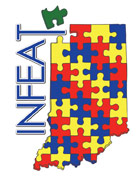Autism is a neurobiological disorder that usually becomes apparent in children before the age of three. It severely impairs a child’s communication and social interactions. Unable to learn from the natural environment as most children do, the child with autism shows little (or abnormal) interest in the world and the people around him. While all children with autism develop some normal or even advanced skills, they exhibit a wide range of behavioral deficiencies and excesses.
A simple screening tool: The Checklist for Autism in Toddlers (ChAT)
As parents of children with autism, we feel that it is very important for you (parents of newly-diagnosed children with autism) to understand that autism is truly a “spectrum” disorder. That is, there are children who present on the low end of the spectrum (sometimes diagnosed as “PDD-NOS” or “mildly autistic” or as having “autistic traits, tendencies or characteristics”), children who present on the high end of the spectrum (often labeled “severely autistic” with possible mental retardation), and children who present everywhere in between. But the important thing to know is that they are all autistic, and will all benefit, in varying degrees, from the same teaching methodologies. But because they are all so unique, there is no one-size-fits-all answer. All of our children have potential, and you, as parents, are the ones who will help your child reach his or her fullest potential–speech therapists, special ed. teachers, doctors and consultants can’t do it for you.
Click here to view the diagnostic criteria for autism found in the Diagnostic and Statistical Manual of the American Psychiatric Association (Version V), which is generally referred to as the “DSM 5.”
Children with autism may exhibit some or all of the following behavioral symptoms:
- absent or delayed speech and language
- may at times seem deaf
- little or no eye contact
- unusual, odd behaviors including severe tantrums, self-injurious behavior and self-stimulatory behaviors (“stims”)
- echolalia (echoing words and phrases of others rather than forming his/her own)
- unusual ways of relating to people, objects, and events
- abnormal responses to sensations, such as sight, hearing, touch, smell, taste, pain (apparent insensitivity) and balance
- resistance to change/insistence on sameness
- absent or abnormal play skills (e.g. examining, stacking, sorting, lining things up)
- difficulty with fine motor functions or lack of coordination (although some children may exhibit areas of unusual ability such as advanced drawing skills or exceptional balance)
- lack of appropriate fear (e.g. of heights, etc.)
- social withdrawal
- lack of interest in people (“treats people like furniture”)
- lack of pointing or exhibiting joint attention
- hand-leading to indicate wants/needs
- ritualistic or perseverative behavior such as arranging objects into neat rows, gazing at spinning objects for extended periods of time, waving fingers in front of the eyes repeatedly, and insisting on particular routines.
Left untreated, autism inhibits a child’s developmental growth to such a degree that most autistic children will require lifelong support.
It is estimated that autism may now affect as many as 1 in 88 children nationwide.
